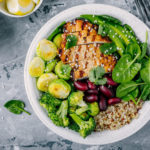Should I Eat Like A Caveman?
I’ve been reading a lot about the so-called hunter gatherer diets which emphasize consumption of meats, fish, fruits, vegetables, nuts and seeds. What do you think of the Paleolithic diet?
Andrew Weil, M.D. | February 20, 2002

Originally published Feb. 2002 – updated Oct. 2011
The Paleolithic diet or Paleo diet and its variants, such as the Primal Blueprint diet, are attempts to recreate, using foods that are readily available in the modern world, the nutrient-rich diets of early human beings. Before the advent of agriculture roughly 10,000 years ago, our ancestors ate what they could hunt and gather: lots of wild game, fish, wild greens, tubers, fruits and nuts, all of which have abundant vitamins, minerals, fiber and other healthful constituents. They managed without salt, sugar, dairy foods, vegetable oils, and grains. Compared to the modern diet filled with processed foods, it appears that our ancestors had a better way of eating, although it is unlikely that we would find many of the actual foods they ate appealing.
A strict Paleolithic diet means no dairy products, wheat, soy, sugar, legumes, seeds, peanuts, starch, sugar, or caffeine. Followers typically eat large quantities of vegetables and lesser amounts of high-quality protein such as wild-caught fish, organic eggs, and free-range beef and chicken. They also eat low-sugar fruits such as blueberries, and modest quantities of nuts.
The concept of pursuing a Paleolithic diet for health reasons has been around since the mid 1970s. My impression is that most long-term followers are young people who are very committed to the diet regime and are also into heavy workouts, although lately I find more older people getting into it and reporting successes such as weight loss, reduced allergic reactions and resolution of type 2 diabetes.
I would agree that strict avoidance of processed and manufactured foods is a worthy goal, and a paleo regime can lead to better health. For example, Darryl Cuilla, 40, general manager of the True Food Kitchen in Newport Beach, Calif. has been on the Paleo diet for the past three years. He tells me that before he adopted it, he was 40 pounds heavier and had bad acid reflux. The doctors he saw recommended surgery. Instead, he changed his lifestyle, inspired to do so when his gym ran a six-week competition called the “Paleo Challenge” that involved a change to a Paleo diet plus exercise to enhance performance and speed recovery from workouts. After six weeks of strict Paleo eating, along with four to five days a week of strenuous exercise, Darryl dropped the 40 pounds, his strength and cardiovascular capacity (endurance) rose 30 percent, and his acid reflux disappeared. He admits to occasional “cheats” of pizza, tortilla chips, and Mexican food, but on a daily basis, he relies on lean animal protein, as many green vegetables as possible, and avocados for fat.
There’s no harm, and some potential benefit, in trying the Paleo diet, but I believe the diet is too restrictive for most people to stick with long term. I think success is more likely for the majority if they regard it as healthy direction, rather than as a strict set of guidelines from which one can never deviate. My anti-inflammatory diet is similar, but less restrictive than the Paleo approach. It emphasizes whole, unprocessed foods – especially vegetables – but also allows for low-glycemic grains and dairy products in moderation. I think this is the diet that will likely work best for most people – it provides a wider choice of healthy foods, promotes general health, helps normalize weight in combination with regular physical activity, and gives the best protection against the most common chronic diseases.
Andrew Weil, M.D.











